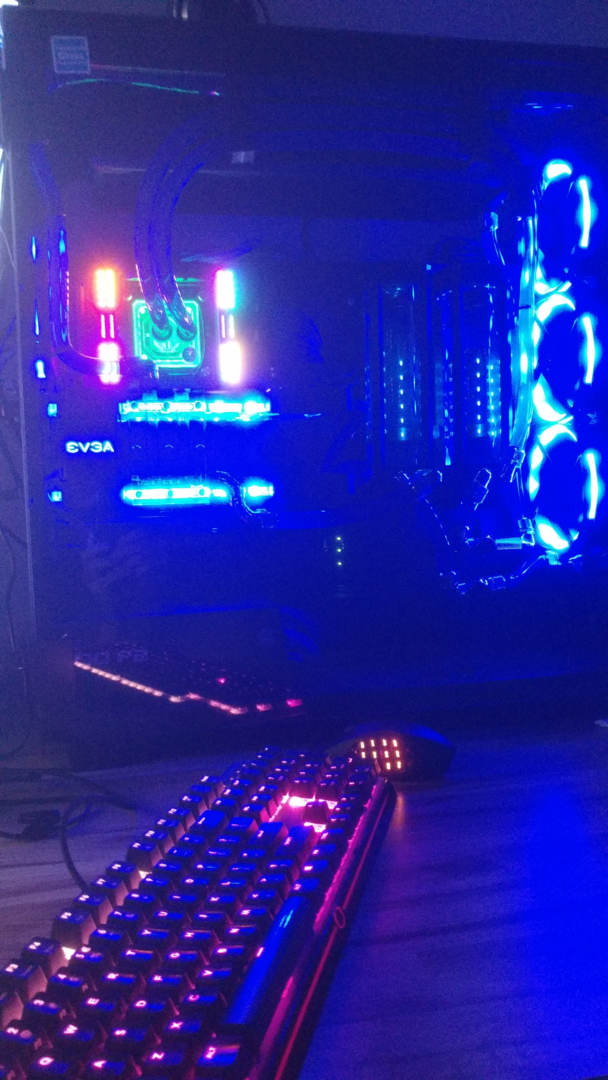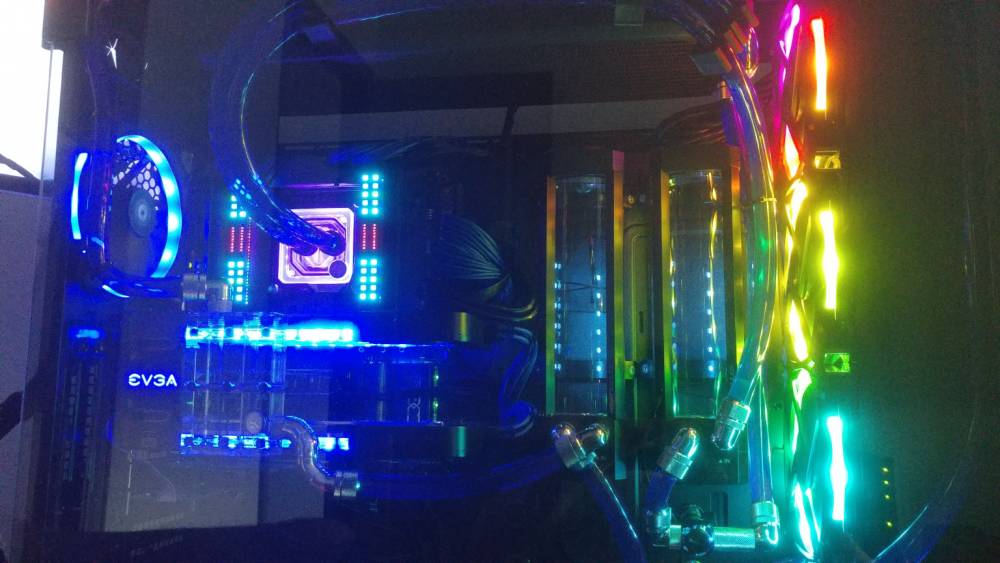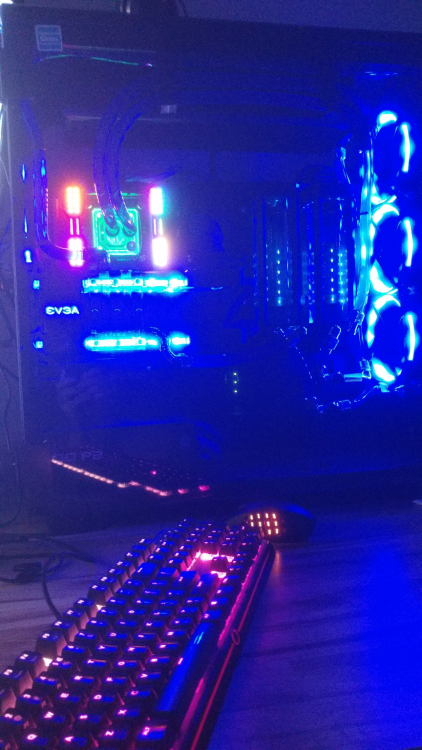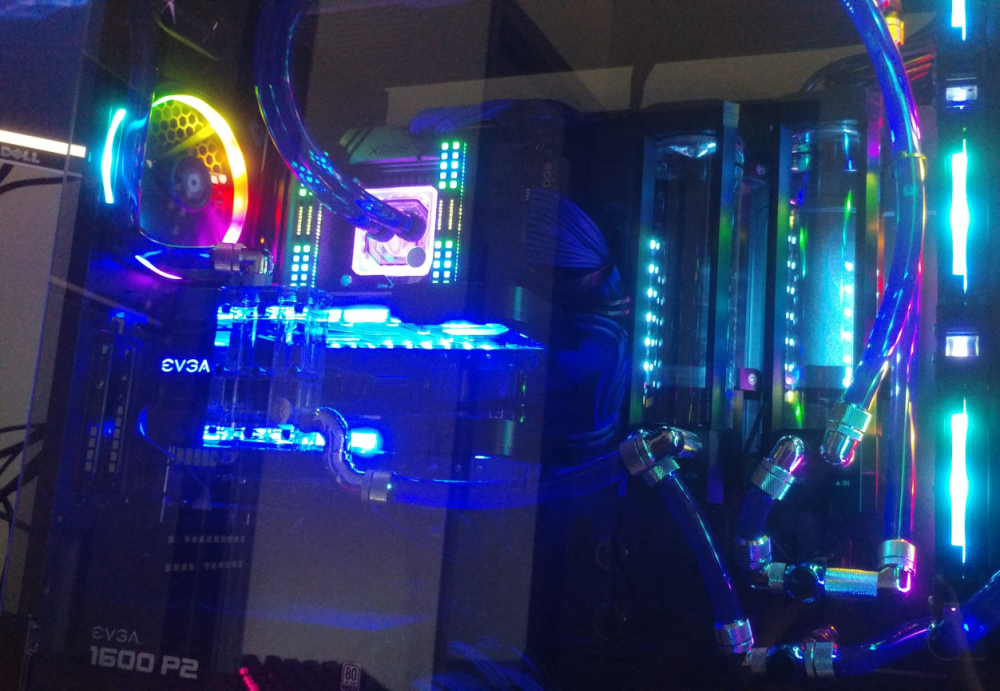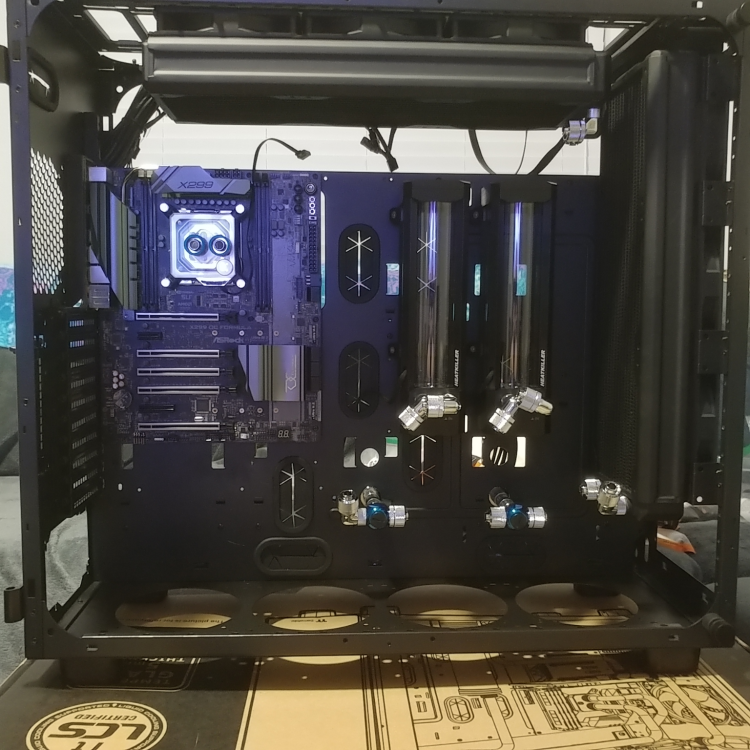-
Posts
6 -
Joined
-
Last visited
RetroRambler's Achievements

Beginner (1/10)
0
Reputation
-
RetroRambler changed their profile photo
-
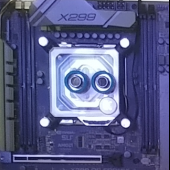
Patriot - Semi-Modded View 91 9980XE rig
RetroRambler replied to RetroRambler's topic in System Builds
A few pics with the lights on a couple different ways. Been trying to get away from the default rainbow swirl effect and settle on something more tasteful lately. PS: Sorry for the reflections from the room in the pics.- 2 replies
-
- non-fanboy
- view 91
- (and 3 more)
-
Hi, Since I used a View 91 building this rig and I did some customization on the case to get what I want out of it, I thought I'd share a few pics. I'm not looking for any followers, awards or "corporate sponsorsheeip" here -- this isn't a 100% TT rig and no apologies will be made for that -- I'm just sharing a few pics and ideas for "other" things that can be done with this very large case. There are fancier and nicer looking ways to do some things I've done here. For example, I agree that custom bent hard tubing can be better looking than soft tubing. The tubing brackets up top may be a little tacky but it works. I just don't have much spare time or money anymore and can't spend all of it obsessing over the appearance of my rig. So a lot of the thinking building my stuff anymore is about reliability and what is practical, keeping stuff out of my way for ease of maintenance, etc. -- rather than bling and showing off the latest-greatest junk to convince you to buy it. Anyway, here goes. Basic Specs Thermaltake View 91 RGB Plus case ASRock X299 OC Formula board, BIOS v1.60 (2) Hardware Labs Black Ice Nemesis 420GTX Dual-Core Extreme Profile rads (2) Watercool Heatkiller Tube 200 DDC reservoir/pump combos Intel 9980XE CPU, EK Velocity RGB block (Loop 1) 4x8GB Corsair Dominator DDR4-3000 RAM (2) EVGA GTX 1080 FTW's with EK full cover blocks (Loop 2) and Watercool GTX 1070/1080 RGB lighting strips dual boot Windows 7 SP1 / Fedora Linux The TT Riing Plus 14 fans are used only for internal case ventilation and exhaust. I use other fans as my main rad fans that I can fully control under Windows and Linux without special software. A few mods I've done or am looking into: 1. Removed all the grilles from the bottom of the case and cut out a piece of black foam-filled project/posterboard to fully cover the inside of the bottom of the case and close off the four 140mm fan holes cheaply and decently. This also completely works around the poor implementation of the air filter on the bottom of the case, ie, that it will not sit flush/flat against the case because it is under-dimensioned and all those 140mm grille screws get in the way. There is an extra piece of the black foam posterboard cut to size for the PSU. The thickness of the two pieces fills out the space between bottom of the case and where the PSU sits when screwed in nicely. 2. All non-essential brackets, posts, etc. removed from inside of case to make room to mount two res/pump combos to the mobo tray/main panel. Again, not trying to win any corporate sponsorship here -- I like these reservoirs because they are VERY well made -- the tubes are made out of real (and THICK) glass with good o-rings, and the housings and struts are *machined* out of aluminum and POM/acetal. They also sell replacement parts, o-rings, etc. and various parts and lighting options for them so they're versatile and more of a durable, reusable long-term investment that can be maintained than something you will throw out and replace the next time you build or update. BTW I really don't understand mounting a radiator completely inside of a case. Call me old school but once upon a time the point of watercooling with a radiator and fans was to put that radiator in contact with the cooler ambient air temps OUTSIDE the case, not show off the radiator. But hey, whatever... 3. Planned/measured locations and drilled the mobo tray/main panel out with a 13/16" / 21mm carbide hole saw to pass the loop drainage lines through to the back side. The bulkhead fittings are located between the drive mounting brackets so the drives can still be mounted in the rear using the stock sleds and brackets. You'll see a couple extra bulkhead fittings with plugs on the mobo tray/panel just to the right of the PSU. This will provide more rad options later. Drives are mounted on the back side with fans mounted over them to keep them cool, using the stock "univeral multifan brackets" the chassis comes with. 560 rad in the bottom? I haven't started the OC process on the 9980XE yet so I don't know that I would even need more than a dedicated 420. If I do, an idea I have in my back pocket (if I can come up with a good plan to relocate the PSU) would be to put a 560 rad into the bottom of the case. I am pretty sure it would just "drop in" and why else would there be four 140mm cutouts across the bottom of the case like that? Always nice to have options and it would nice to be able to put a 560 in the case without having to get the Dremel tool out to make it fit. I haven't completely finished implementing loop drainage on the back side yet so I'll hold off on any more pics of the back for now -- still have to figure out what fittings etc. to string together to drain loops nicely through the bottom. But if I need to drain either loop for some reason before then I can attach a drain hose to the back side of the bulkhead fitting(s). Will follow up with a few more pics of the rig running with lighting. Cheers, RetroRambler Back side (before I cut the extra pair of passthrough holes seen above): And, closer to being finished and ready to fill and leak test:
- 2 replies
-
- non-fanboy
- view 91
- (and 3 more)
-

TT RGB Riing Plus Software causing AMD GPU Driver HARD crash
RetroRambler replied to merkage's topic in Case Fan
Update: It took a little while (>1 day) but I have had another TDR happen with my Nvidia cards, this was with no TT RGB Plus running. So I don't think I can fairly blame this problem just on the RGB Plus software. But the frequency has dropped a LOT. I am, however, quite happy to have found Teszty66's alternative software here on the forums. It allowed me to save a different default color scheme to the TT controller for bootup (and when I am in Linux) so I don't have to put up with the rainbow swirl default anymore, and it has amazing potential for fan customization also. Funny really, that the only reason you can't save/change the power-on default color scheme with TT's RGB Plus from among the ones built in to the little controller chips on the fans themselves is because Thermaltake hasn't bothered to code that functionality into their tool. Cheers, RetroRambler -
Teszty66 thank you VERY MUCH for your work. Even if all I end up using your software for is to set a different default boot RGB lighting mode for my Riing Plus fans, you have provided functionality that the hardware manufacturer failed to implement in their software. #### impressive, sir.
-
Hello, The subject pretty much says it, I am looking for a way to control the lighting of the Riing Plus 14 fans my View91 RGB Plus edition case came with that does not rely upon software. I don't like the default rainbow swirl effect of these fans but do not want to have to run software like RGB Plus to set some other lighting mode. There are a couple reasons behind this. One is that I run Linux at least half of the time and there is no RGB Plus software for Linux. It is silly to have to boot first into Windows and then reboot into Linux just to get rid of the rainbow swirlie fan lighting mode. I would be happy with a single static color if it came down to that. I've looked at the TT Sync Premium 9 port controller hub, but frankly there is not a clear word of what it really can and can't do. It *SOUNDS LIKE* to control the lighting of connected Riing Plus fans separately from using RGB Plus software (that I am trying to get away from), I would have to feed in a 5V RGB (Addressable RGB?) signal from my motherboard, and would have to use the motherboard's RGB software (Aura, Polychrome, etc.). But my motherboard only has the older standard 4-pin (non-addressable) 12V RGB headers. A couple specific questions: 1. Is it true that the 9-port TT Sync controller can take RGB lighting control input from an addressable RGB controller (presumably motherboard 5V Addressable RGB header) and it simply passes/copies that signal coming in to all connected Riing Plus RGB fans? (ie, all fans connected to the 9-port TT Sync controller have the exact same lighting, whatever comes in on the input port?) 2. Could this then, in theory, be ANY addressable RGB header of the right signal/pinout type? 3. Then if #1 and #2 are true, does anybody know of a third-party addressable RGB controller completely implemented in hardware that could provide that ARGB signal input the 9-port TT controller wants? Thanks, RetroRambler
-

TT RGB Riing Plus Software causing AMD GPU Driver HARD crash
RetroRambler replied to merkage's topic in Case Fan
Hello, I stumbled across this thread looking for an alternative way (hardware, preferably) to control the fans and RGB lighting of the Riing Plus 14's in my View91 RGB Plus case, and am glad I did. While I am not sure yet, upon finding this thread and thinking about the problems I've been having, I am now looking at the RGB Plus software as a factor or cause for my display TDR (Timeout Detection and Recovery) problems, since NVidia GPU users have also reported seeing the same problems as the OP here . I am running RGB Plus version 1.2.4, which except for a brief period with a newer x64-specific version that didn't work well for me (v1.2.9, I think), is the main and/or only version of this software I've ever run. I have generally allowed the RGB Plus software to start automatically with Windows since I despise the default rainbow swirl lighting the Riing Plus 14 fans have until the software starts up. I also dual boot Linux. So yeah, I'm trying to find another way to control the lighting and fan speed of these fans. I have ZERO problems in Linux BTW so I am not entertaining the possibility of defective hardware. Below are some details of the issues I've been dealing with, in case it "rings any bells" for anyone else. System overview: ASRock X299 OC Formula mobo, BIOS v1.6.0 (have also experienced issue with other BIOS versions) Thermaltake View 91 RGB Plus case with 4 included Riing Plus 14 fans and controller (2) EVGA GTX 1080 FTW GPU's, SLI disabled (also occurs when enabled but I don't game much or otherwise need SLI, I run 2 cards because I have 6 monitors) NVidia driver version 391.35 (and several other highly-reputed-as-stable driver versions both newer and older) Intel 7940X CPU / Intel 9980XE CPU (I have 2 of these rigs, both have experienced the issue. My 7940X rig is overclocked , my 9980XE rig is not (YET)). Windows 7 x64 SP1 + misc critical fixes 32GB RAM using stock XMP profiles built into RAM SPD config The main way I see this problem manifest is while using Firefox with Hardware Acceleration enabled and just using the browser, particularly when multiple browser windows are opened. Things that make it happen faster are - doing a lot of scrolling with the mouse wheel, and more commonly when it is Youtube I am hitting with the browser. I have only been able to ~"stop" the TDR's from occurring in Firefox by completely disabling hardware acceleration in Firefox -- merely setting the two advanced layer options (layers.mlgpu.enabled and layers.mlgpu.enable-on-windows7) to false in about:config doesn't completely stop it for me. Even setting the registry DWORD value TdrDelay in the right place with an 8 second delay vs. the 2 second default TDR value isn't enough, hardware acceleration has to be completely disabled in Firefox or I will eventually start getting TDR's. Up to this point I've been tracking/working on this problem primarily as a Firefox+Nvidia driver problem, there have been people complaining about this happening with Firefox for a LONG time now (as in, YEARS). It doesn't help that Nvidia and Mozilla have both claimed multiple times they have "fixed" the issue with different driver and/or browser release versions, but it continues to go on. Anyhow, since closing the TT RGB Plus app (ie, fully exiting it where you don't see it in the processes list anymore in Task Manager) and preventing it from starting up automatically at Windows startup I have, thus far, not seen another TDR. I do know that the RGB Plus software has a "local" HWInfo .DLL it uses to get system temps, etc. and since I run HWInfo64 on my rig also, perhaps there is a conflict but I am not giving up the HWInfo64 I run myself, I wish you could just turn off RGB Plus's monitoring of system sensors with a checkbox. If you hide/rename the local HWInfo DLL RGB Plus has in its local dir the util won't run (it errors out). Generally speaking I have been trying to avoid allowing any "resident" (always running) software that either performs hardware sensor monitoring (other than the HWInfo64 setup/instance I *WANT* to use) and/or controls RGB lighting. My own experiences have confirmed what everybody says about RGB control software out there, it is all VERY buggy. At least with the rest of the RGB software I use to configure lighting, I only have to run it when I want to make a change, the lighting config gets saved in hardware. Sadly you don't seem to be able to save the lighting setup you want for the Riing Plus 14 fans in the controller, so you either run RGB Plus resident in Windows or it's rainbow swirlie time again... Question: Has anyone found a version of RGB Plus that they do not see the issue reported by OP? Thanks, RetroRambler

